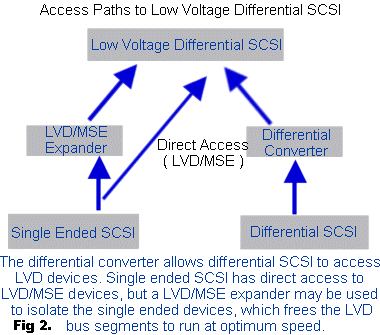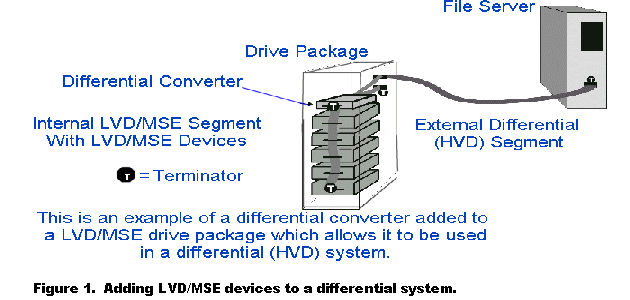Supporting HVD Systems with LVD Devices Written for Computer Technology Review's December '99 issue For years SCSI has had two defined physical interfaces; Single Ended and Differential. Each had their strengths and weaknesses. Whereas single ended SCSI devices were less expensive to make, differential SCSI devices could communicate over longer cables and were less susceptible to external noise influences. Both interfaces carved out their places in the market. The single ended SCSI interface became the interface of choice for internal applications, and low end systems, where price was the deciding factor. The robust nature of differential SCSI and the longer cable lengths associated with it, made it the interface to use in applications where SCSI devices were to be external to the computer. Differential SCSI always had a higher cost associated with it. The 64 mil. drivers required for differential (HVD) systems drew too much current to be able to drive the bus with a single chip. Single ended SCSI required only 48 mil. drivers and could be implemented within a single chip. Most device manufacturers produced single ended versions of their devices before they made differential versions, if they even bothered to make differential versions. All this made differential hard to get and expensive compared with single ended. There is however, still a demand for differential SCSI, from many mid-range and large systems manufacturers, and from those that service the large base of differential SCSI systems in the field. The high cost and low availability of differential SCSI devices also created a market for devices that converted single ended SCSI to differential SCSI such that both device types could coexist on the same bus.
Differential SCSI along with its single ended alternative had reached the limits of what would be physically reliable in transfer rates, even though the flexibility of the SCSI protocol allowed for implementing much faster communications. Another problem has been the confusion of having two physical interfaces to choose from in implementing a SCSI system, since single ended and differential devices were not directly compatible with each other. Low Voltage Differential SCSI (LVD) is the answer to both problems associated with the physical SCSI interface. The 24 mil. LVD drivers can be easily implemented within a single chip, and have the low cost elements of single ended interfaces. LVD is also able to drive the bus reliably over distances comparable to differential SCSI. LVD adds to this by being able to support communications at faster data rates, such that SCSI can continue to increase in speed without having to change from the LVD physical interface. With LVD SCSI there are now wide Ultra-2 speed devices which have 80 megabyte transfer rates. Products have also been released that support Ultra-160 SCSI, which provides 160 megabyte transfer rates. The advent of the Multimode implementation of LVD SCSI which is being called LVD/MSE, allows single ended SCSI applications to smoothly upgrade to LVD devices. LVD has made an impact such that the SPI-3 specifications for SCSI do not even define the (HVD) differential bus anymore. SPI-2 may have the last complete definition of the HVD bus. Almost all hard disk drive manufacturers have discontinued their line of HVD drives, with many of them standardizing on LVD/MSE drives as their only SCSI interface type. There are still manufacturers of HVD SCSI tape drives and other back-up and disaster recovery devices, but the trend is for the new versions of these devices to also be LVD/MSE in the near future. Systems based on HVD SCSI have no direct way of using the new LVD interfaces without adding a single ended or LVD host adapter, which may not be available for that system. This leads to a number of problems for those who are selling, using, maintaining or upgrading these systems. Differential Converters Are The Answer The Differential Converter is a SCSI Expander that is designed to resolve such problems. The current class of HVD converters separate the SCSI bus into two segments such that one segment is HVD and the other segment is LVD/MSE. This allows for adding single ended and/or the new LVD devices to a differential system. Example: There is a requirement to upgrade the speed and capacity of a drive package in a differential SCSI based system, but the fastest and highest capacity hard disk drives have only come out in LVD. The new drive package is added to the system by mounting a differential converter inside the package. This allows the system to access the drive package like it was a differential one. (See Figure 1) Many differential (High Voltage Differential) SCSI systems in use today do not have an easy way to get a LVD host adapter installed. There are other systems that may not get this type of upgrade for quite some time. In some cases, the system is spread out in the facility such that single ended cabling is much too short to be used. These systems range from new installations to installations that are several years old, but still need support with device replacements and additional storage. They all can use a differential (HVD to LVD) converter to get access to the latest devices and still retain the differential (HVD) host adapter, HVD devices and the installed cabling. Another advantage of using the HVD to LVD differential converter is when or if the system is able to get a LVD host adapter, the new devices can go directly to the host adapter. In the mean time, the HVD differential system can have access to the latest in storage devices, and be able to maintain its storage hardware without having to look for HVD devices which have become extremely hard to find. Differential converters have been in existence since almost he beginning stages of SCSI. Many converters were developed for specific OEM applications. There are also a number of SCSI device manufacturers producing differential converters made for use in any applications that require a conversion between differential and single ended SCSI. These same companies are now manufacturing converters between HVD differential and LVD/MSE SCSI. All of these converters allow targets and initiators on both the HVD and LVD/MSE sides. This allows LVD/MSE based systems to be configured to still use any differential devices that are available, along with providing differential systems access to LVD/MSE devices. Differential converters provide the link to the new devices for HVD SCSI based systems that single ended systems already enjoy. (See Figure 2) Today the market for such devices has grown to the point that ASICs have been developed which handle all of the conversion controls, have built-in LVD/MSE drivers and only need the HVD transceivers to finalize the conversion. There should be a time when HVD differential converters will not be needed, but this will only happen once the large base of HVD differential SCSI systems are completely upgraded to the new LVD standard, which may take many years to occur. Until then, HVD to LVD converters will play a major role in making older SCSI technology work with the new wave of SCSI devices. Marc D. Brooks is an active member of the STA and founder and CEO of Paralan Corporation, a manufacturer of SCSI bus enhancement products (Expanders). | ||||||||||||||||||||||||||||||||||
|
Paralan Corporation 4655 Ruffner Street, San Diego, CA 92111 Sales: (800) 479-7719 | Tel.: (858) 560-7266 | Fax: (858) 560-8929 | E-mail: info@paralan.com |
||||||||||||||||||||||||||||||||||

Custom Search
|




